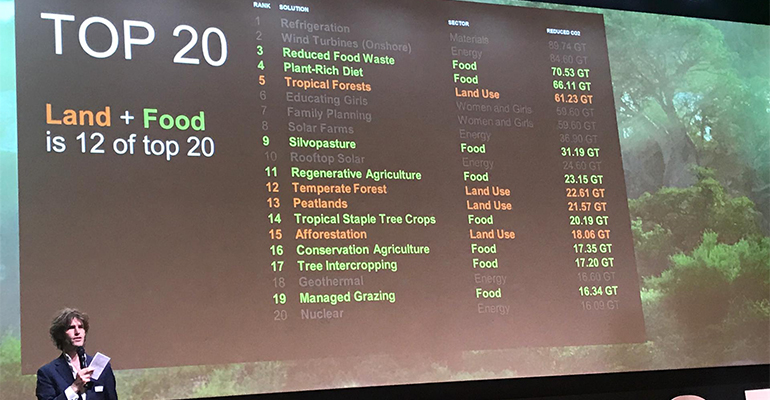
100 solutions to help combat global warming

Sven Jense, founder and director of Climate Cleanup, presented an up-to-date list of these promising solutions at the most recent international Green Mind University conference. Every year BNP Paribas Fortis organises this event in conjunction with ‘greentech’ consultancy Greenfish in order to promote opportunities linked to the transition to a low-carbon, sustainable economy among companies and institutions.
Sven Jense made a powerful impression with his One Hundred Climate Solutions for the Next Thirty Years, which are aimed not only at a worldwide reduction in CO2 emissions but also the removal from the atmosphere of already-emitted carbon dioxide. The target is what is known as the ‘drawdown point’, i.e. that point in time when the concentration of greenhouse gases in the atmosphere stops increasing and begins to decline again.
The Climate Cleanup project ranks the 100 solutions according to their efficiency in combating greenhouse gas emissions, also taking into account their costs and achieved emissions savings. Here are the top ten:
1. Windpower
Windpower stands at the top of the list of initiatives for tackling global warming over the next three decades and achieving a carbon-neutral world by 2050. Currently there are some 314,000 wind turbines in operation, generating just under 4% of the world’s electricity supply. According to Sven Jense, windpower could perhaps become the cheapest source of electricity within ten years.
2. Solar farms
In the desert, on military bases, at landfill waste dumps or even out at sea – these days you can find solar panel installations everywhere. With solar panels, the sun provides an unlimited, free source of clean fuel, at an unchanging cost price that is a fraction of the cost of conventional energy sources.
3. Less food waste
A third of all foodstuffs that are produced are never eaten. This waste equates to approximately 8% of total annual worldwide CO2 emissions. The solution is to practice sustainable consumption, producing only what we need and not throwing away perfectly edible food.
4. A high vegetable diet
This might well be hardest thing for some of us, but it’s nevertheless a fact that eating a bit less meat would be good for the planet. Meat-eating is the basic cause of no less than a fifth of all worldwide CO2 emissions. Following a vegetable diet not only means lower emissions but is healthier for us, reducing the incidence of chronic illnesses. A study published in 2016 calculated that we could reduce greenhouse gas emissions by 63% if we all switched to a vegetarian diet, and by as much as 70% with a vegan diet.
5. The right to education for girls in developing countries
Research reveals that women who spend longer at school tend to have fewer, and healthier, children and also remain economically active for longer. Providing girls in developing countries with a thorough education can therefore help to stem population growth and raise national productivity.
6. Rainforest recovery
Deforestation, woodland fragmentation, forest fires, degradation and exhaustion of biodiversity: in the past, tropical forests used to cover no less than 12% of the earth’s surface; nowadays this figure is just 5%. So it’s high time we marked out areas where nature can be left to do its thing and tropical forests can be allowed to grow back.
7. Improved cooking methods
Some three billion people worldwide still cook their food over an open fire or on a rudimentary stove. As fuel they use wood, coal, charcoal, animal dung and crop residues. Taken together, this is the cause of 2- 5% of annual greenhouse gas emissions. And cooking often takes place indoors, where there is limited ventilation. The smoke that is given off causes some 4.3 million premature deaths every year. Using advanced cooking technology, such as biomass stoves, can reduce emissions by no less than 95%.
8. Residential solar panels
Have you installed solar panels on your roof? You’re not alone. No less than 30% of all solar panels around the world are installed on roofs at residential properties. This is an ideal way to supply your own household with electricity and so reduce the need for supplies from public power grids.
9. Improving cooling circuits, air conditioning systems and refrigerators
Every refrigerator and every air conditioning system contains chemical coolants that reduce the temperature by absorbing heat. At one time, those chemical coolants used to do a lot of damage to the ozone layer. So it’s vital to choose the right chemicals if we want to be kind to the planet. Natural coolants such as propane and ammonium are now increasingly being used, and they are also showing highly promising results on the CO2 emissions front.
10. Free-range livestock farming
Last but not least among these top ten solutions is free-range livestock farming. This means rearing livestock in natural surroundings, not restricted to a specifically allocated field or grazing area. This is much more effective in reducing methane output. Meadows that are criss-crossed with trees absorb five to ten times as much carbon – both into the vegetation and the ground – as open grassy fields. This approach may also bring other advantages for the farmer: the extra tree fruits, plus nuts, berries and mushrooms, can help to provide a diversified income stream across the different seasons.
Would you like to view the entire top 100? Then go to https://www.drawdown.org/solutions/table-of-solutions.